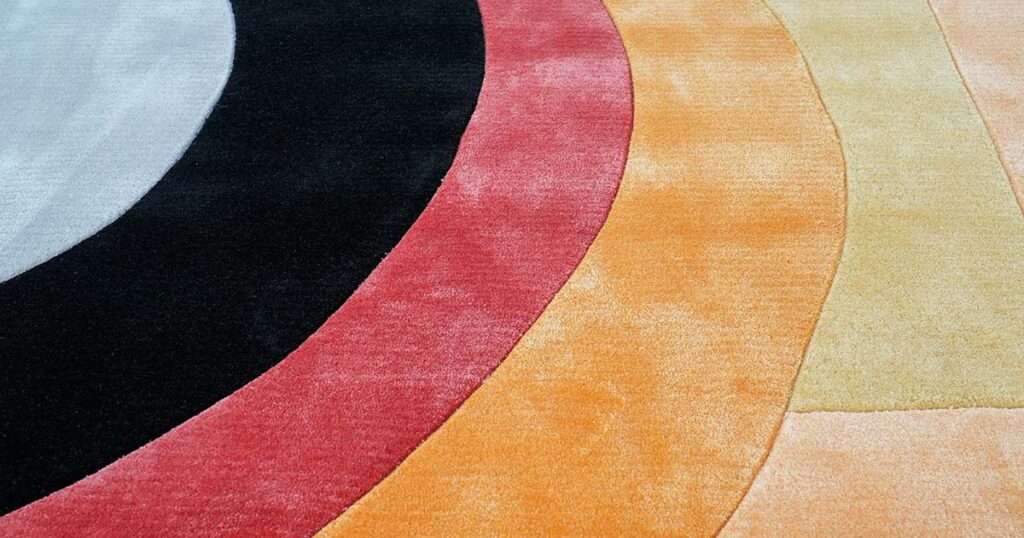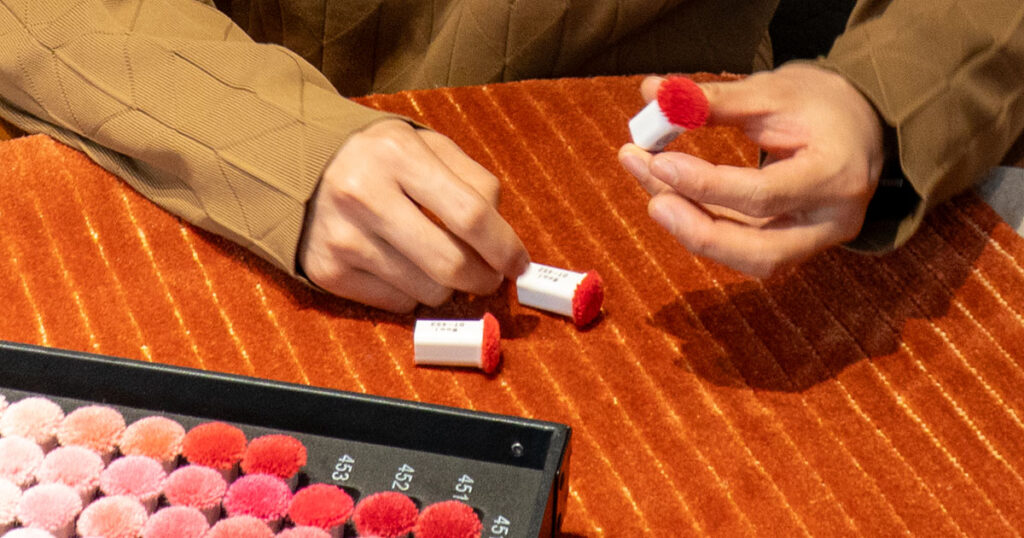Custom tufted rugs do more than just cover floors—they anchor spaces, tie design elements together, and tell stories that enhance commercial environments.
For businesses investing in custom floor coverings, the initial research and inspiration phase is crucial.
This guide explores the rich sources of inspiration available to you as a commercial buyer, helping you create rugs that will elevate your spaces while reflecting your brand identity.
Role of Custom Rugs in Commercial Spaces
In commercial environments, a thoughtfully designed rug serves multiple functions simultaneously.
It acts as the foundation of your space’s aesthetic, defines zones within open layouts, improves acoustics by absorbing sound, and guides foot traffic.
Most importantly, it can become a powerful branding tool that communicates your company’s values and identity.
Unlike standard mass-produced rugs, custom tufted rugs give you complete control—not just over size and shape, but over every aspect of design, from color palette to pattern complexity, pile height variation, and material selection.
This level of customization ensures your rug complements your space perfectly while fulfilling specific commercial requirements.
Drawing Inspiration from Architecture and Geometry
Architecture provides a natural starting point for rug design inspiration, particularly for commercial spaces where architectural elements often play a prominent role.
Look closely at the buildings that inspire you—whether it’s the ornate patterns of a historic façade, the symmetry of classical Greek columns, or the sleek lines of modern skyscrapers. These elements can be abstracted and translated into rug patterns that echo your space’s architectural context.
For example, a boutique hotel housed in an Art Deco building might commission a rug with bold, angular patterns in gold and deep blue, drawing directly from the building’s geometric motifs. A corporate headquarters in a glass-and-steel tower might opt for a rug with subtle linear patterns that mirror the clean lines of the architecture.
Even the existing elements within your space can provide inspiration—floor tile patterns, ceiling coffers, window shapes, or lighting fixtures can all inform your rug design, creating a harmonious dialogue between your floor covering and its surroundings.
Interior Design Styles & Rug Expressions
Different commercial environments call for different design approaches. Understanding how rugs complement various interior styles can help you choose a direction that enhances your specific space.
Traditional Style
Traditional commercial spaces—like law firms, financial institutions, or classic hotels—benefit from rugs with timeless elegance. These typically feature:
- Intricate, symmetric patterns derived from Persian or Oriental designs
- Formal medallion centers with ornate borders
- Rich, deep color palettes featuring burgundies, navy blues, forest greens, and golds
- Balanced proportions and classic motifs like florals or palmettes
A traditional-style rug lends gravitas and sophistication to a space, signaling established values and attention to detail. For commercial applications, consider updating these classic patterns with slightly contemporary color schemes to maintain relevance while honoring tradition.
Modern and Contemporary Style
Forward-thinking businesses, creative agencies, and cutting-edge retail spaces often embrace modern design aesthetics. Modern-style rugs typically feature:
- Clean, abstract designs with minimal ornamentation
- Geometric patterns like chevrons, hexagons, or asymmetrical shapes
- Neutral color palettes (grays, whites, beiges) with strategic pops of vibrant color
- Simplified motifs with plenty of negative space
Contemporary rugs can function as floor art, making bold statements that energize a space. A tech company might choose a rug with a circuit-inspired pattern in high-contrast black and white, while a modern restaurant might opt for an abstract design that complements its brand colors.
Eclectic Style
Boutique hotels, creative studios, and businesses aiming to project a unique personality often embrace eclectic design. Eclectic-style rugs can:
- Mix and match patterns from different cultural traditions
- Combine unexpected color combinations
- Feature global motifs from tribal or folk traditions
- Incorporate vintage elements with contemporary touches
These rugs can become conversation pieces that set your commercial space apart from competitors. An eclectic rug might combine Moroccan geometric patterns with contemporary color gradients, creating a distinctive look that captures attention.
Minimalist Style
Spas, high-end retail spaces, and businesses projecting refined simplicity benefit from minimalist rug designs. These typically include:
- Simple or absent patterns, focusing instead on texture
- Monochromatic or tonal color schemes
- Natural, undyed materials like wool, sisal, or jute
- Subtle details like slight variations in pile height
In minimalist commercial spaces, a rug provides tactile comfort and acoustic benefits without competing visually with other elements.
The quality of materials becomes paramount—think hand-tufted rugs in varying shades of soft gray in an abstract, cloud-like pattern that adds depth while maintaining serenity.
Regional & Cultural Design Aesthetics
Commercial spaces often benefit from connecting to their location or demographic through cultural references in their rug designs.
North American Influences
North American commercial spaces often blend comfort with regional character:
For coastal businesses, consider rugs featuring blues, whites, and natural fibers that reference ocean themes. Mountain resorts might incorporate rugged textures and earth tones inspired by the surrounding landscape.
In urban settings, rugs can reference city grids or local landmarks in abstract ways. A hotel in Chicago might feature subtle architectural motifs inspired by the city’s famous skyline, creating an immediate sense of place.
Southwestern influences bring rich opportunities for commercial spaces in those regions—geometric patterns inspired by Native American designs can connect a space to local heritage while providing striking visual interest.
European Design Elements
European-inspired rug designs span from minimalist Scandinavian simplicity to Mediterranean warmth:
Scandinavian-influenced designs feature light colors, simple patterns, and natural materials—perfect for businesses projecting a clean, thoughtful image. A Nordic-inspired restaurant might choose a hand-woven wool rug in ivory with subtle gray geometric lines.
Mediterranean designs incorporate warmer palettes—terracottas, deep blues, and olive greens—often with motifs from Moorish tiles or Greek key patterns. A Spanish-inspired boutique hotel might feature rugs with geometric trellis patterns in spice-market reds and oranges.
For spaces aimed at projecting luxury, consider rugs inspired by French Aubusson or Savonnerie traditions, with refined florals and scrollwork in elegant color combinations.
Middle Eastern Richness
Middle Eastern design aesthetics offer commercial spaces opportunities for creating memorable, distinctive environments:
Geometric patterns from Islamic art—interlocking stars, polygons, and arabesques—provide visually stunning motifs that work in both traditional and contemporary settings. Even minimalist spaces can incorporate these patterns in tone-on-tone executions for subtle sophistication.
Color plays a crucial role in these designs, with bold jewel tones (deep plum, ruby red, sapphire blue, emerald) creating rich, layered experiences. High-end retail environments can benefit from the opulent feel these color combinations create.
Persian influences, with their intricate patterns and rich symbolism, remain universally appealing and influential in contemporary carpet design. A luxury hotel lobby might feature a massive custom rug with Persian-inspired motifs reinterpreted in modern colors, creating an impression of timeless elegance.
Contemporary Trends with Commercial Longevity
While timelessness matters for commercial investments, incorporating select current trends can keep your space feeling relevant and fresh.
Sustainable Materials and Biophilic Design
Commercial spaces increasingly incorporate sustainability and natural elements:
Rugs made from undyed wools, plant fibers, or recycled materials communicate environmental consciousness. The organic textures of these materials—nubby wool, woven jute, or recycled yarn—add tactile interest while signaling your business’s values.
Biophilic designs that reference nature—abstract patterns resembling flowing water, stone striations, or botanical elements—create connections to the natural world. A corporate headquarters might choose a rug with subtle leaf motifs or a pattern resembling ripples in water, bringing nature’s calming influence indoors.
Artistic Expression in Commercial Rugs
Commercial spaces increasingly use rugs as artistic statements:
Abstract, painterly designs that appear hand-drawn or feature watercolor-like effects bring unique character to corporate environments. A creative agency might commission a rug that resembles an abstract expressionist painting, with free-form shapes and dynamic color relationships.
Gradient effects and ombré patterns—transitioning smoothly from one color to another—create subtle visual interest in minimalist spaces. A contemporary hotel might feature gradient rugs that shift from deep blue to soft gray, referencing the transition from ocean to sky.
Rugs as Storytelling Elements in Commercial Spaces
Perhaps the most powerful use of custom rugs in commercial settings is as storytelling vehicles that connect with customers and reinforce brand identity.
Brand Identity Expression
Your custom rug can communicate your brand values and history:
Consider incorporating subtle references to your founding year, company milestones, or industry through abstract motifs in the pattern. A publishing house might feature a rug with a pattern inspired by printed text, or a technology company might incorporate circuit-board motifs into their lobby rug.
Color choices should align with your brand palette, either directly matching corporate colors or complementing them. This creates visual cohesion between your rug and other branded elements in the space.
Location-Specific Design Elements
Commercial spaces benefit from connecting to their geographic context:
Hotels and restaurants can incorporate local cultural motifs or landmarks into their rug designs, creating an authentic sense of place. A luxury resort in a coastal location might feature a rug pattern inspired by local marine life, connecting the interior experience to the surrounding environment.
Climate and landscape can inform color choices—desert properties might embrace warm earthy tones, while northern locations might incorporate cool blues and forest greens. These subtle references help root the commercial space in its location.
Experiential Design
Commercial rugs can actively contribute to the customer experience:
Consider how your rug design might guide movement through your space—perhaps subtle directional patterns lead toward key areas, or changes in color zone different functional areas. A museum might use rug designs to subtly direct visitor flow between exhibits.
Hospitality venues can use rugs to create different mood zones—more energetic patterns in social areas, calmer designs in relaxation spaces. The rug becomes part of the emotional journey through your commercial environment.
Practical Implementation Considerations
While aesthetics drive inspiration, commercial buyers must balance creativity with practical requirements:
Traffic patterns should inform both material choices and design complexity—high-traffic areas benefit from simpler patterns that won’t show wear as readily and durable materials that can withstand frequent cleaning.
Consider maintenance requirements specific to your industry—healthcare facilities need antimicrobial properties, restaurants need stain resistance, and hotels need rugs that can withstand frequent professional cleaning.
Plan for the future by choosing designs with some flexibility—will your rug still work if you update wall colors or furniture in five years? Is it tied to specific branding that might change?
Scale matters significantly in commercial spaces—patterns that look appropriate on a sample might appear too busy or too subtle when expanded to fill a grand lobby. Work with designers who understand how patterns translate across different scales.
From Inspiration to Implementation
The journey from inspiration to installed rug typically follows these steps:
Begin by collecting reference images, color samples, and pattern ideas that resonate with your commercial goals. Create a mood board that captures the feeling you want your space to evoke.
Work with experienced custom rug designers who understand commercial requirements and can translate your inspiration into feasible designs. They can advise on appropriate materials, pile heights, and construction methods for your specific needs.
Review digital renderings that show how the rug will look in your actual space, or request physical samples to evaluate colors and textures in your lighting conditions. This critical step ensures the final product will meet expectations.
Allow adequate time for production and installation—custom commercial rugs typically require 8-12 weeks from final approval to installation, depending on size and complexity.
Ready to Transform Your Commercial Space?
Contact our design team to discuss your custom tufted rug project.
We’ll guide you through the process from initial concept development through production and installation.
Ensure your investment enhances your commercial environment while telling your unique story through exceptional craftsmanship.



